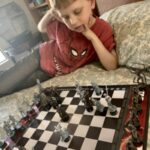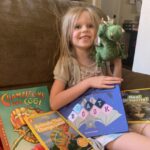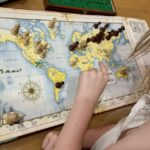Killing the Desire

I came across this quote: “We have to abandon the idea that schooling is something restricted to youth. How can it be, in a world where half the things a man knows at 20 are no longer true at 40—and half the things he knows at 40 hadn’t been discovered when he was 20?”
Agree! And this had me thinking along the lines that we also need to get away from the idea that formal learning is the best or primary way to learn. The majority of what I know today that has made the biggest impact on my life is what I learned on my own because I wanted to know, and not the things I was forced to “learn” because I had to know it for a test (then promptly forgot). That’s why I strive not to kill that natural desire of my children to know through methods of force, and instead, attempt to develop and nurture it through gentle guidance.








I’ve seen it. You probably have too. I know I experienced it myself—a child, eager to start school, yet not long into it, the light in the eyes has gone out. No longer does the child desire to learn. School becomes something we just have to “get through.” Why is this? And what can we do to prevent this? Do kids just have a propensity toward laziness? We can all be lazy at times, but I don’t think that’s the reason.
Learning comes natural to a child. Think of the complicated things they learn at early ages while overcoming great obstacles. Failing again and again, they continue to try. Crawling, walking, talking—the list could go on. I mean, I haven’t mastered a new language, but an eighteen month old child picks up a new language at amazing speeds. We tend to take these things for granted, never really think how hard these young children work to accomplish these tasks. Yet, they don’t see it as work.
Someone once said, “Play is the work of childhood.” Play is work. Maybe, if I could see my work as play, I’d not give up so easily. Imagine your little baby saying, “Well, I fell down and bumped my head while trying to walk. Ain’t gonna ever try that again!” That’s how we adults tend to react. Children just get right back up. They want to learn; they want to know. That’s what motivates little sissy to get into the trash fifteen different times in the same day, the same hour! Not naughtiness, but a desire to know. There are some very interesting things to be found in there.
We’ve taught our children learning is work, and work isn’t supposed to be fun. That play is frivolous and imagination a complete waste of time.
What kills that childhood determination? Why, halfway into first grade, are children seemingly lazy, bored, frustrated, or downright loathing school? I think unfortunately the answer often lies with us. They haven’t failed. We failed them. We’ve taught them learning is work, and work isn’t supposed to be fun. That play is frivolous and imagination a complete waste of time. “Quit daydreaming! Get back to work!” I submit that we kill the desire.
The truth is learning is fun though it is sometimes hard work. Learning can also be play, and daydreaming is the fountain from which discoveries spring. So the question is: how can we keep that light in their eyes? When I notice my kids becoming frustrated or bored with whatever subject or topic we are studying, rather than assuming it is laziness, I first explore a few other likely explanations.
1. They don’t understand.
Sometimes the reason my child is frustrated is because they simply don’t understand the material or concept, and it’s not because they are not putting forth an effort. The reason for their lack of understanding may be the method. The way it is being taught may conflict with their learning style. Every child is different. We tend to teach either in the way we were taught or in accordance with our own learning style. This is not necessarily bad, but we may need to take into consideration that the reason that they are not “getting it” is because we are not presenting it in a way they can understand.
One book I always recommend to any parent whether they homeschool or not is Discover Your Child’s Learning Style by Mariaemma Willis, M.S. and Victoria Kindle Hodson, M.A. This book has been a great help to me. There is considerably more to learning style than simply whether we are visual, auditory, or kinetic. In reality, everyone learns best when all their senses are engaged. Reading aloud, for example actively engages us both visually and auditorily. However, a child’s learning style is about more than just the method, but includes the environment, which can either hinder or help a child’s ability to focus. Children may have different needs when it comes to lighting, ambient sound, body position, and the time of day studies are conducted.
Forcing a concept on a child before they are developmentally ready can cause a child to become discouraged and hate learning.
Another possibility that may be hindering a child’s ability to comprehend may be that they are simply not yet ready. Children do not learn to walk, talk, or ride a bike at the same age. Why should we expect them to all read, write, or understand certain mathematical concepts at the same age or pick them up with the same ease?
I have one child that picked up reading quickly but was much slower at understanding mathematics and another that was exactly opposite. It had nothing to do with one child be “smarter” or another being “behind.” They are simply different. I try to work with and not against those differences allowing them to work at their own pace. They may be “ahead” in once subject and “behind” in another. That’s okay! We need to set aside preconceived or societal expectations as to when a child is supposed to be able to do or understand certain material. Now, if they are very far behind, there may be cause for concern, but usually our worries are not reality. If we relax and set aside something for a day, week, month, or even a year, it is amazing what a fresh start can accomplish when the child’s brain has matured.
I remember being concerned that my firstborn, though he knew all his letters and sounds, could not identify which letter a word began with. He memorized that “dog” began with “d,” but if I asked him which letter “duck” began with, he had no clue. I set aside all formal teaching for about six months as I had just had a new baby. When we started up again, within one month he was reading, and by the end of the school year, he was ready to begin 2nd Grade readers! When he was ready, he picked it up with ease. How glad I am that I didn’t try to force him to read before he was ready and risk potentially causing him to abhor reading.








2. They have mastered the material.
Sometimes what might appear as laziness is simply boredom. The child has mastered the concept and is ready to move on, but instead is forced to do what amounts to busy work in order to complete the material. Here’s a little secret if you haven’t already discovered it for yourself—you don’t have to complete every page in the workbook. It’s okay to skip. In fact, if the child has mastered the concept, it may be the best thing to do. Some children pick up concepts quickly and don’t need the repetitive reinforcement. It only succeeds in frustrating them.
I know some of us are completionists and we hate the idea of leaving a blank page or an activity undone. Yet what is more important? Every box checked and blank filled or keeping the joy of learning in our child’s eyes? Of course, reinforcing concepts from time to time is necessary for even the fastest paced learner. So, here is what you can do with those extra pages—organize them into a folder and save them for review. Or even better, use the information to make a trivia game.
3. The material we have provided is boring.
Sometimes a child is bored because their schoolwork is boring. It’s not that they don’t understand. It’s not that they have mastered the concept. It is simply boring because it is. Don’t misunderstand, learning is not boring, but the way we are teaching it can be.
I see little reason for large quantities of “seatwork.” With the exception of math I use textbooks and worksheets minimally. Rather I emphasize reading, writing, conversation, and activities. Replace seatwork with activities that engage the child—experiments, nature walks, and creative writing. Supplement textbooks with videos and storybooks. Reinforce concepts through games and conversation. I know this requires more work on our part and more planning, but it will also reap more rewards when the child is drawn into learning.








4. The child has been too stationary.
It’s a simple fact that when we have been sitting too long we lose focus. This is true for all ages, but more so for children. Children by design are meant to move. Their young, growing bodies crave physical activity. It is neither healthy nor natural for a child of elementary age to sit still for hours in a day. Let them stand at the table. Give them freedom to get up and move around. Eliminate unnecessary or repetitive worksheets to free up more play time. Remember the quote from earlier? “Play is the work of childhood.”
Play isn’t frivolous; it is necessary to the development of the child physically, emotionally, and mentally. As one researcher put it: “The experience of play changes the connections of the neurons at the front end of your brain, and without play experience, those neurons aren’t changed.” Ample time should be given to the child for free, unstructured play. And not as a “reward” because they accomplished their “work,” but with the understanding that play is just as vital to their learning and development as any other aspect of their education.
Joy is the key to learning. You can’t force someone to learn. They must want to.
Play also can clue us in on what the child has learned. I’m not a fan of tests for early elementary and use them only sparingly for upper elementary. Often I can better understand what concepts a child has grasped by talking with them, or allowing them to “teach” me. Tests can sometimes be deceptive. Sometimes a child can know something but simply not be “good” at test taking. Or they can rehash information on a test without truly understanding it.
One way I can gauge what my child understands is by paying attention to their play. Nothing makes this homeschool mom’s heart sing more than when I overhear my children incorporating something we discussed in school into their play and with no prompts from me. They don’t even realize I’m listening. It lets me know that they were not only paying attention, but they enjoyed it. And joy is the key to learning. You can’t force someone to learn. They must want to.








5. We have not set an example.
The most important thing a parent teaches their child is their attitude. And we are teaching attitude all day, every day, whether we mean to or not. If we want to develop our children into lifelong learners, we—the parent—must also be a learner.
Remember the quote at the top? Learning isn’t just for youth. If you are not growing, you’re dying. If we want our children to be readers, they should see us reading. If we want our children to be excited about a topic, we must be excited about the topic. If we have the attitude, “Well, I had to learn this as a child, so you must too.” Our children will adopt the attitude that school is just something to get through in order to do more important things. But, if they see us enjoying learning new things every day, they will realize that learning is for all stages of life.
A few years back, I began writing my first novel. I spent hours a day writing. My eldest daughter, eight at the time, who previously showed little interest in reading and writing, suddenly was on the computer writing her own novel without me ever once suggesting she should do so. Do not underestimate the power of example.
If our children see us enjoying learning new things every day, they will realize that learning is for all stages of life.
So ask yourself: What have I learned this year? One of my greatest joys is learning with my child. I don’t know everything. Sometimes my children teach me. You see, when you raise children to love learning, they will learn beyond the school material you provide.
A couple years back we were studying insects. My eldest son has loved bugs since he was little—more accurately, he feared bugs, which inspired him to learn more about them. He often reads about them in his free time. I love it when I’m teaching through the material and my child adds, “Yes, and did you know…” and proceeds to tell me what they already knew—things I did not teach them. That is the ultimate joy of being a homeschool parent—seeing my child’s eyes shine with a love for knowledge.
Check out Educating the Heart, Soul, and Mind.
Thank you for reading. Keeping a blog going, though fun, is a lot of work. If you found this post helpful, consider buying me a cup of coffee. If you haven’t already, you can subscribe for more posts like this one below.
Happy Homeschooling!

Pingback: Understanding Homeschooling: What It Is and What It Isn’t - Leanna Rapier
Pingback: Let’s Talk About Socialization! - Leanna Rapier